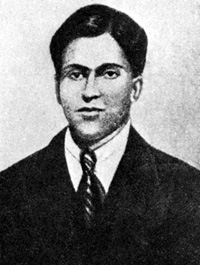Badal Gupta
Badal Gupta | |
|---|---|
বাদল গুপ্ত | |
 | |
| Born | 1912 |
| Died | 8 December 1930 |
| Cause of death | Suicide by consuming potassium cyanide |
| Nationality | Indian |
| Other names | Sudhir Gupta |
| Known for | Writers' Building attack |
| Memorials |
|---|
Badal Gupta (Template:Lang-bn Badol Gupto) (1912–1930) was a Bengali revolutionary nationalist who fought against British rule over India.
Early activities
Badal Gupta was born Sudhir Gupta in the village Purba Shimulia (East Shimulia) in the Bikrampur region of Dhaka, now in Munshiganj District, Bangladesh.[1] Badal was inspired by Nikunja Sen, a teacher of the Banaripara School of Bikrampur, and as a result, Badal joined the Bengal Volunteers. Badal Gupta was also influenced by the revolutionary activities of his two paternal uncles Late Dharani Nath Gupta and Nagendra Nath Gupta, who were involved in the Alipore Bomb Case and were imprisoned along with Rishi Aurobindo Ghosh.
The battle at Writers' Building
Bengal Volunteers targeted Col NS Simpson, the Inspector General of Prisons, who was infamous for the oppression of the prisoners in the jails.[citation needed] The revolutionaries decided not only to murder him, but also to strike a terror in the British official circles by launching an attack on the Secretariat Building - the Writers' Building in the Dalhousie square in Kolkata.
On 8 December 1930, Badal along with Dinesh Gupta and Benoy, dressed in European costume, entered the Writers' Building and shot dead Simpson. Police in the building started firing at them in response. What ensued was a brief gunfight between the 3 young revolutionaries and the police. Some other officers like Twynam, Prentice and Nelson suffered injuries during the shooting.
Soon police overpowered them. However, the three did not wish to be arrested. Badal took Potassium cyanide, while Benoy and Dinesh shot themselves with their own revolvers. Badal died on the spot.
Significance
The acts of Benoy, Badal and Dinesh inspired further revolutionary activities in Bengal, in particular and India, in general.[citation needed]
After independence, the Dalhousie Square was named B.B.D. Bagh - after the Benoy-Badal-Dinesh trio.
References
- ^ Mohanta, Sambaru Chandra (2012). "Gupta, Badal". In Islam, Sirajul; Jamal, Ahmed A. (eds.). Banglapedia: National Encyclopedia of Bangladesh (Second ed.). Asiatic Society of Bangladesh.
Bibliography
- Hemendranath Dasgupta, Bharater Biplab Kahini, II & III, Calcutta, 1948;
- Ramesh Chandra Majumdar, History of the Freedom Movement in India, III, Calcutta 1963;
- Ganganarayan Chandra, Abismaraniya, Calcutta, 1966.
